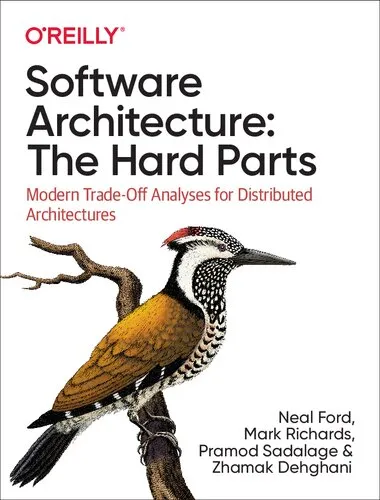Software Architecture: The Hard Parts: Modern Trade-Off Analyses for Distributed Architectures
4.7
Reviews from our users

You Can Ask your questions from this book's AI after Login
Each download or ask from book AI costs 2 points. To earn more free points, please visit the Points Guide Page and complete some valuable actions.Introduction to Software Architecture: The Hard Parts
Modern software systems demand architectures that are robust, scalable, and maintainable. Yet, with distributed systems becoming the norm, architects face increasingly complex choices and trade-offs that test their technical expertise and decision-making abilities. Software Architecture: The Hard Parts: Modern Trade-Off Analyses for Distributed Architectures serves as a beacon for tackling these challenges, offering practical insights into the intricate world of distributed software architecture.
Detailed Summary of the Book
The book dives deep into the core challenges of software architecture, especially focusing on distributed architectures — where complexity often hides beneath layers of abstraction. Authored by seasoned experts Neal Ford, Mark Richards, Pramod Sadalage, and Zhamak Dehghani, the content strikes a balance between theoretical grounding and real-world application.
One of the key highlights of the text is its emphasis on trade-offs. Instead of providing a "one-size-fits-all" solution, the authors explore multiple architectural paradigms, guiding architects on how to evaluate the pros and cons of each approach based on the context. The book covers critical topics such as data consistency in distributed systems, microservices choreography versus orchestration, API design, component coupling, and team autonomy.
Through practical examples and frameworks, the text arms architects with the tools to navigate difficult design decisions. Additionally, it delves into organizational dynamics and governance, areas often overlooked but essential for successful architectural outcomes in distributed systems.
Key Takeaways
The book delivers actionable insights for software architects, offering lessons that resonate across different domains and industries.
- Understand the impact of distribution on architectural components such as data stores, APIs, and workflows.
- Learn to perform trade-off analyses for distributed architectures by considering consistency, scalability, and maintainability.
- Explore advanced topics like microservices communication models and how they influence system behavior.
- Discover techniques for managing organizational constraints and aligning architecture with business goals.
- Master event-driven architecture patterns and their applicability in modern distributed systems.
Famous Quotes from the Book
Wisdom and inspiration abound throughout the book, and some of its most memorable quotes serve as guiding principles for architects:
"Software architecture is the art of balancing trade-offs. With distributed systems, every decision has consequences you must understand and factor into your design."
"The hardest part of architecture isn’t knowing the right answers but asking the right questions to expose the trade-offs inherent in every possible solution."
"Collaboration between teams is both an architectural and organizational problem. Solving one without addressing the other rarely leads to success."
Why This Book Matters
In the rapidly evolving landscape of software development, architects face new challenges that require not only technical expertise but also the ability to navigate uncertainty and make informed trade-offs. Software Architecture: The Hard Parts illuminates and demystifies these challenges, delivering a comprehensive toolkit for tackling distributed architectures.
This book is invaluable because it equips architects with the skills to evaluate architectural decisions against business and technical requirements systematically. Unlike many architectural texts, it doesn’t shy away from the "hard parts." It tackles them head-on, offering insights and strategies that are directly applicable to real-world scenarios.
It’s not just a book for software architects—it’s a book for engineers, team leads, and anyone involved in designing systems intended to last. With its focus on trade-off analysis, team dynamics, and modern architectural patterns, it bridges the gap between theory and practice, fostering a deeper understanding of distributed systems architecture.
Free Direct Download
You Can Download this book after Login
Accessing books through legal platforms and public libraries not only supports the rights of authors and publishers but also contributes to the sustainability of reading culture. Before downloading, please take a moment to consider these options.
Find this book on other platforms:
WorldCat helps you find books in libraries worldwide.
See ratings, reviews, and discussions on Goodreads.
Find and buy rare or used books on AbeBooks.
1102
بازدید4.7
امتیاز50
نظر98%
رضایتReviews:
4.7
Based on 0 users review
"کیفیت چاپ عالی بود، خیلی راضیام"


